I’ve starting doing the SOAP Bible study method with my kids recently. They’re both six years old. We’ve found that this particular Bible study method is accessible for both adults and kids, and it’s easily adaptable for the littles.
When we starting using this method, and once we adapted it for the kids, I was completely blown away with the results. It got the kids engaged with Scripture.
Instead of fighting with each other, or drawing ninjas and bad guys (completely unrelated to the lesson), or complaining about being bored, they engaged with what we were doing and participated in the study, reflection, and prayer.
Disclaimer: This post contains affiliate links. Using these links means I may earn a percentage of the purchase at no extra cost to you. As an amazon associate, I receive a percentage of qualifying purchases. View our disclosure policy here.

What is the SOAP Bible Study Method?
The SOAP Bible study method is a simple way to engage with Scripture and apply it to your life. The acronym makes the method easy to remember.
SOAP stands for:
- Scripture
- Observation
- Application
- Prayer
All you need to do the SOAP Bible study method is a Bible, a journal, a pen, and a passage of Scripture.
That makes this method easily approachable for those who are either new to Bible study, or who don’t have time for a longer, more involved Bible study method. It also makes it super simple to use with the kids.
SOAP is about:
- reading a passage of Scripture,
- listening for what God is trying to say to you through that piece of Scripture,
- reflecting on how you can take any Biblical truths that you find there into your life.
Adapting the SOAP Bible Study Method to Use with Kids
When we did the SOAP Bible study method with our intergenerational small group, I chose to read the passage aloud (twice). While I did this, I had the adults write down their observations.
The key with the kids is this: they had the option to write down their observations (for those kids old enough to write, and to write fairly quickly) or to draw their observations.
This was a total game changer.
The kids followed the same structure as the adults, but they chose to draw pictures in response, instead of recording their observations in words.
Honestly, I was blown away by how well they engaged with the passage when we allowed them to interact with Scripture in a way that appealed to their interests and their skill level.
When we tried this the first time, we used 1 Corinthians 13, the passage about love, since it was approaching Valentine’s Day.
I read the passage from the NIV Adventure Bible for Kids. That made the language a lot more accessible to the kids and made a huge difference in terms of their attention to the passage and their engagement.

And what did the kids do?
They all drew battle scenes.
It was honestly kind of amazing.
They picked up on the parts of Scripture that said that love protects, and that love resists evil.
And each kid drew a picture of love defeating evil.
It was adorable. And kind of profound.
My kids, of course, love to turn everything into battle scenes. So it wasn’t a big surprise that they did so here too.
But they took their inclinations towards drawing ninjas defeating bad guys, monsters versus heros, and they applied it to Scripture. They took the lessons in the passage (that love is victorious over evil) and they expressed that creatively. (All the kids had hearts in their battle scenes).
One of my twins even offered to pray for us at the end.
Blown. Away.

How we adapted the SOAP Bible study method to use with the kids was basically this:
- Allow the kids to draw their responses to Scripture.
- Ask them the same questions as the adults.
Scripture: What words, phrases, and ideas stand out of you?
Observation: What do you observe about the passage? What do you note about the characters or events? What is happening in the passage? How does it fit into the greater story of the Bible?
Application: How can you apply this to your life?
Prayer: Offer a prayer in response.
When doing this with kids, you should also read the passage aloud at least twice. This is especially important with kids who are still learning how to read.
Read the passage once through aloud and ask the kids to note any phrases, words, or ideas that stand out to them.
Read the passage through again, slowly, and ask them to draw any observations and applications that they can draw from the passage, using the questions above. You can also split this step up: read the passage a second time for observation, and a third time for application. It really depends on the patience of your audience how many times you should read through it.

Awesome